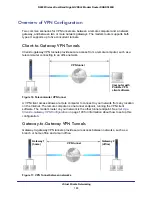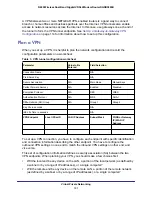
Virtual Private Networking
101
N600 Wireless Dual Band Gigabit VDSL2 Modem Router DGND3800B
A VPN between two or more NETGEAR VPN-enabled routers is a good way to connect
branch or home offices and business partners over the Internet. VPN tunnels also enable
access to network resources across the Internet. In this case, use gateways on each end of
the tunnel to form the VPN tunnel endpoints. See
Set Up a Gateway-to-Gateway VPN
Configuration
on page
114 for information about how to set up this configuration.
Plan a VPN
When you set up a VPN, it is helpful to plan the network configuration and record the
configuration parameters on a worksheet:
Table 3. VPN tunnel configuration worksheet
Parameter
Value to Be
Entered
Field Selection
Connection Name
N/A
Pre-Shared Key
N/A
Secure Association
N/A
Main Mode
Manual Keys
Perfect Forward Secrecy
N/A
Enabled
Disabled
Encryption Protocol
N/A
DES
3DES
Authentication Protocol
N/A
MD5
SHA-1
Diffie-Hellman (DH) Group
N/A
Group 1
Group 2
Key Life in seconds
N/A
IKE Life Time in seconds
N/A
VPN Endpoint
Local IPSecID
LAN IP Address
Subnet Mask
FQDN or Gateway
IP (WAN IP
Address
To set up a VPN connection, you have to configure each endpoint with specific identification
and connection information describing the other endpoint. You have to configure the
outbound VPN settings on one end to match the inbound VPN settings on other end, and
vice versa.
This set of configuration information defines a security association (SA) between the two
VPN endpoints. When planning your VPN, you should make a few choices first:
•
Will the local end be any device on the LAN, a portion of the local network (as defined by
a subnet or by a range of IP addresses), or a single computer?
•
Will the remote end be any device on the remote LAN, a portion of the remote network
(as defined by a subnet or by a range of IP addresses), or a single computer?
















































